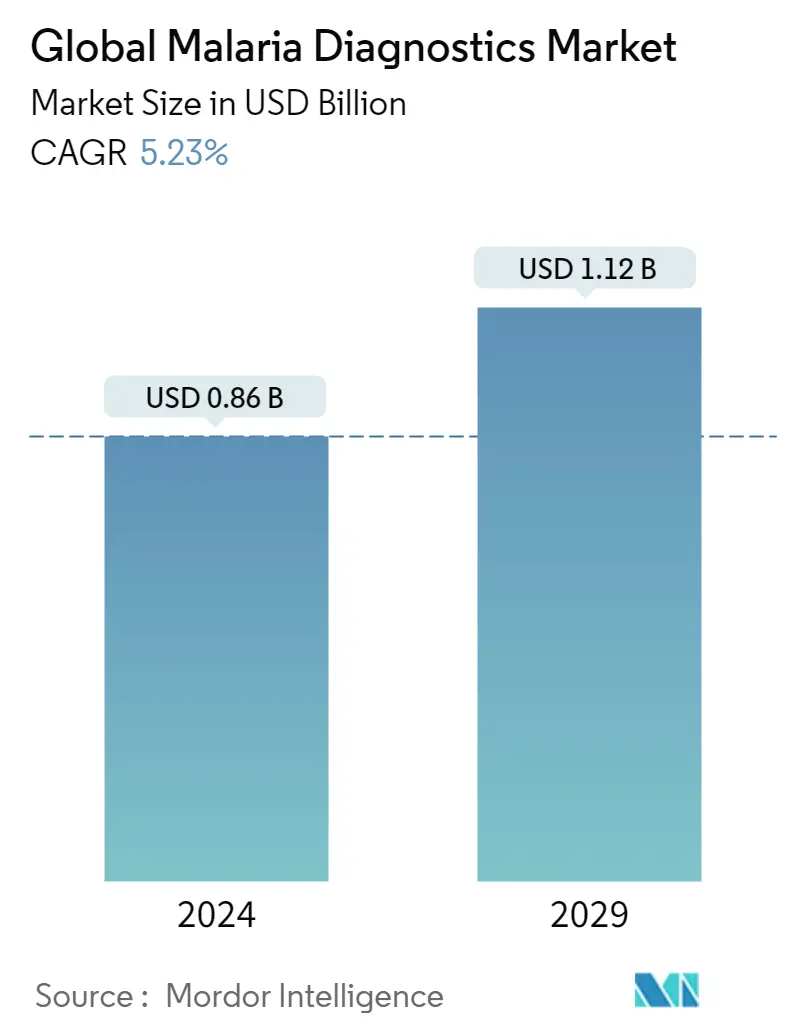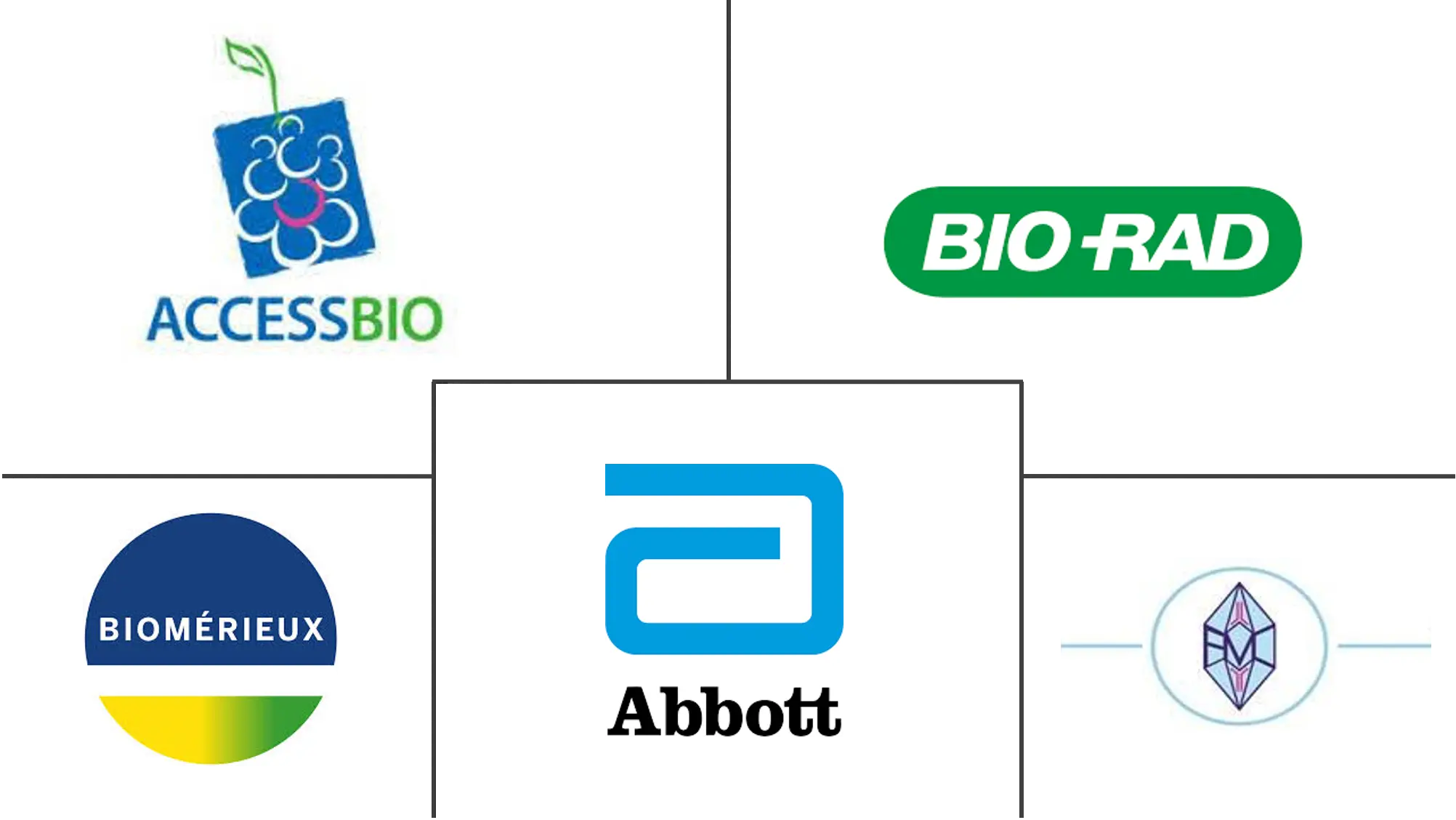Market Size of Global Malaria Diagnostics Industry

| Study Period | 2019 - 2029 |
| Market Size (2024) | USD 0.86 Billion |
| Market Size (2029) | USD 1.12 Billion |
| CAGR (2024 - 2029) | 5.23 % |
| Fastest Growing Market | Middle East and Africa |
| Largest Market | North America |
| Market Concentration | Low |
Major Players
*Disclaimer: Major Players sorted in no particular order |
Malaria Diagnostics Market Analysis
The Global Malaria Diagnostics Market size is estimated at USD 0.86 billion in 2024, and is expected to reach USD 1.12 billion by 2029, growing at a CAGR of 5.23% during the forecast period (2024-2029).
The COVID-19 pandemic is expected to have a significant impact on the market. According to an article titled, 'Diagnosing malaria and other febrile illnesses during the COVID-19 pandemic' that appeared in The Lancet online magazine in April 2020, social distancing measures implemented to manage COVID-19 were making it difficult for personnel to access patients with fever, potentially compromising testing and diagnostics for the disease. Additionally, according to another article published in July 2020 titled, 'Identifying and combating the impacts of COVID-19 on malaria', children and pregnant women would bear a disproportionate burden of excess malaria mortality arising from COVID-19-related disruption of health systems and malaria control programs, particularly in sub-Saharan Africa. This is primarily because the current COVID-19 pandemic is disrupting malaria diagnosis as both these diseases share some symptoms. It is because of these factors that the malaria diagnostics market is expected to be affected during the COVID-19 pandemic.
The factors that are responsible for the growth of this market include the growing demand for diagnostic tools in malaria-endemic regions, the high incidence of malaria in some regions, increasing technological advancements and efficient diagnostics, the scale-up of rapid diagnostic tests, and universal access to diagnosis. The rising demand for diagnostic tools for malaria is one of the primary factors driving the market study. For instance, according to the July 2022 update of the World Health Organization (WHO), there were 241 million new cases of malaria registered in 2020 globally, an increase of 14 million cases from the previous year. Also, as per the same source, a disproportionately large amount of the worldwide malaria burden is found in the WHO African Region and 95% of malaria cases and 96% of malaria deaths occurred in the area in 2020. Hence, due to the high burden of malaria around the world, the demand for malaria diagnostics products is expected to increase which will drive growth in the malaria diagnostics market over the forecast period. In addition, awareness programs and other government initiatives are other factors in market growth. For instance, in July 2022, the Ministry of Health and Family Welfare of India launched Jan Abhiyaans with log bhaagidari (people's participation) to enthuse and engage citizens and communities to ensure that their homes, premises, and neighborhoods are free of mosquitoes. Thus, such initiatives are likely to increase awareness among people thereby providing growth opportunities for the market.
Furthermore, the technological advancement in the malaria diagnostics techniques and launch of new products in the market by the companies in the market along with other business expansion activities such as collaborations, mergers and acquisitions, and expansion are also expected to play a crucial role in the growth of the malaria diagnostics market over the forecast period. For instance, in July 2022, Mylab Discovery Solutions launched a combined RT-PCR test called PathoDetect Extended Monsoon Fever Panel, for monsoon diseases such as malaria, Chikungunya, dengue, Zika, Leptospirosis and Salmonellosis bacterial species, and Leishmaniasis parasites. Therefore, due to the above-mentioned factors, the malaria diagnostics market is expected to grow over the forecast period. However, the increasing number of malaria-free countries and rising demand for low-cost diagnostic tools are expected to hinder the growth of the malaria diagnostics market over the forecast period.
Malaria Diagnostics Industry Segmentation
As per the scope of the report, malaria is a serious life-threatening disease caused by a parasite, transmitted by the bite of infected anopheles mosquitoes. Infected mosquitoes transport the plasmodium parasite. The report studies the different types of methods used for the diagnosis of malaria. The malaria diagnostics market is segmented by technology (clinical diagnostics, microscopic diagnostics, rapid diagnostic tests, molecular diagnostics, and other technologies) and geography (Americas, Europe, Asia-Pacific & Middle East, and Africa). The report offers the value (in USD million) for the above segments.
| By Technology | |
| Clinical Diagnostics | |
| Microscopic Diagnostics | |
| Rapid Diagnostic Tests (RDTs) | |
| Molecular Diagnostics | |
| Other Technologies |
| Geography | ||||||||||
| ||||||||||
| ||||||||||
| ||||||||||
|
Global Malaria Diagnostics Market Size Summary
The malaria diagnostics market is poised for growth, driven by increasing demand for diagnostic tools in malaria-endemic regions and technological advancements in diagnostic methods. The market is expected to expand steadily over the forecast period, supported by the scale-up of rapid diagnostic tests and initiatives aimed at universal access to diagnosis. The high incidence of malaria, particularly in sub-Saharan Africa, continues to be a significant factor propelling market growth. Awareness programs and government initiatives, such as those launched by India's Ministry of Health and Family Welfare, are also contributing to the market's expansion by enhancing public awareness and engagement in malaria prevention efforts. Despite the challenges posed by the COVID-19 pandemic, which has disrupted health systems and malaria control programs, the market is expected to recover and grow, aided by the introduction of new diagnostic products and techniques.
The Middle East and Africa region is anticipated to maintain a dominant position in the malaria diagnostics market, supported by investments from developed countries and the World Health Organization's focus on reducing malaria mortality rates in African countries. The region's high burden of malaria cases and deaths underscores the continued demand for diagnostic products. The market is moderately competitive, with major players like Abbott Laboratories, bioMérieux SA, and Bio-Rad Laboratories Inc. holding significant shares. Collaborative efforts, such as the partnership between SC Johnson and the Global Fund, aim to eradicate malaria, further driving market growth. Additionally, the introduction of new diagnostic kits, like the Plasmochek by the Kenya Medical Research Institute, highlights ongoing innovation and expansion within the market.
Global Malaria Diagnostics Market Size - Table of Contents
-
1. MARKET DYNAMICS
-
1.1 Market Overview
-
1.2 Market Drivers
-
1.2.1 Growing Demand for Diagnostic Tools in Malaria-endemic Regions
-
1.2.2 Increasing Technological Advancements and Efficient Diagnostics
-
1.2.3 Scale-up of Rapid Diagnostic Tests and Universal Access to Diagnosis
-
-
1.3 Market Restraints
-
1.3.1 Increasing Number of Malaria-free Countries
-
1.3.2 Rising Demand for Low-cost Diagnostic Tools
-
-
1.4 Porter's Five Forces Analysis
-
1.4.1 Threat of New Entrants
-
1.4.2 Bargaining Power of Buyers/Consumers
-
1.4.3 Bargaining Power of Suppliers
-
1.4.4 Threat of Substitute Products
-
1.4.5 Intensity of Competitive Rivalry
-
-
-
2. MARKET SEGMENTATION (Market Size by Value - USD million)
-
2.1 By Technology
-
2.1.1 Clinical Diagnostics
-
2.1.2 Microscopic Diagnostics
-
2.1.3 Rapid Diagnostic Tests (RDTs)
-
2.1.4 Molecular Diagnostics
-
2.1.5 Other Technologies
-
-
2.2 Geography
-
2.2.1 Americas
-
2.2.1.1 Venezuela
-
2.2.1.2 Brazil
-
2.2.1.3 Colombia
-
2.2.1.4 Rest of the Americas
-
-
2.2.2 Europe
-
2.2.2.1 Germany
-
2.2.2.2 United Kingdom
-
2.2.2.3 France
-
2.2.2.4 Turkey
-
2.2.2.5 Spain
-
2.2.2.6 Rest of Europe
-
-
2.2.3 Asia-Pacific & Middle East
-
2.2.3.1 India
-
2.2.3.2 Myanmar
-
2.2.3.3 Indonesia
-
2.2.3.4 Pakistan
-
2.2.3.5 China
-
2.2.3.6 Papua New Guinea
-
2.2.3.7 Cambodia
-
2.2.3.8 Rest of Asia-Pacific & middle East
-
-
2.2.4 Africa
-
2.2.4.1 Democratic Republic of Congo
-
2.2.4.2 Nigeria
-
2.2.4.3 Uganda
-
2.2.4.4 Rest of Africa
-
-
-
Global Malaria Diagnostics Market Size FAQs
How big is the Global Malaria Diagnostics Market?
The Global Malaria Diagnostics Market size is expected to reach USD 0.86 billion in 2024 and grow at a CAGR of 5.23% to reach USD 1.12 billion by 2029.
What is the current Global Malaria Diagnostics Market size?
In 2024, the Global Malaria Diagnostics Market size is expected to reach USD 0.86 billion.

